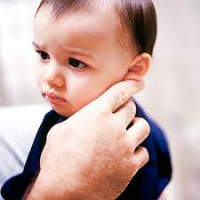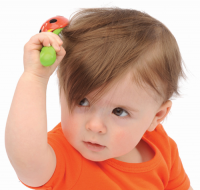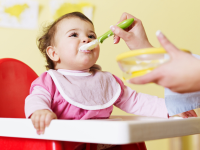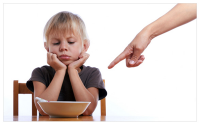Bottle-feeding Basics Perhaps the biggest advantage of bottle-feeding — whether you have a singleton or multiples — is that someone other than Mom can feed the babies. These days, using formula is easier than ever. For a premium price you can buy pre-mixed formula where all you have to do is pour, or you can save some money with concentrated or powdered formulas that you mix yourself. Even if you're breastfeeding, there will be times when you'll want to give your babies bottles: When someone else takes the night shift so you can sleep. When you want to breastfeed one child individually. (Some experts recommend doing this once every day or so to promote mother/child bonding.) When you have more than two breastfeeding babies and want to feed them simultaneously. Don't let the threat of "nipple confusion" scare you away from using bottles, especially if your babies are doing well with breastfeeding. "Nipple confusion is less of an issue if you tickle the baby's upper lip with the bottle's nipple and let the baby do some of the work," says Catherine Watson Genna, IBCLC, a New York City-based international board-certified lactation consultant. Choose a slow-flow nipple. Genna says bottles tend to be too fast for baby's comfort, especially in the first weeks of life or when baby is preterm, and keep the nipple reservoir only half-full of milk so the baby has to really suck. How can one person bottle-feed two babies at once? Until babies are old enough to hold their own bottles, it requires coordination. Some people place each baby in a baby seat or infant carrier, with babies either facing each other or the person holding the bottles. Other people modify the football hold to accommodate bottles, positioning babies with a V-shaped, angled breastfeeding pillow. In the beginning, it may take a little time to find the feeding position that's most comfortable for you and your babies. And just the same, it may take a little time to find the feeding situation that's most practical for you and your family — breastfeeding, bottle-feeding ... or both!
How To Cleaning Baby Ear The outside of the ear and the ear hole. While on the inside there are various organs of hearing. Ears need to keep it clean, but just the outside or the earlobe only. * Besides having its own cleaning system, ear hole newborns is still difficult to enter stemmed cotton (cotton buds). Do you actually hurt him. Humming gently, or take the baby talk while you clean the ears. * Prepare all the equipment before starting to clean the baby's ear. ie : round cotton, cotton-stemmed, a container of warm water, baby oil, and a washcloth or handkerchief soft towel. * Dampen a cotton round with warm water, then wipe the front and back of the earlobe. * Ear notched section can be cleaned with a slightly in-stemmed cotton soaked in warm water or baby oil.
తల్లికి కాలుష్యం బిడ్డకి ఆయాసం వాతావరణ కాలుష్యం, పొగలు శిశువుల్ని పుట్టక ముందు, తల్లి కడుపులో ఉన్నపుడే దెబ్బతీస్తున్నాయి అంటున్నారు పరిశోధకులు. గర్భిణీ ఎంత మేర కాలుష్యాన్ని పీలిస్తే, ఆమె కడుపులోని బిడ్డ శ్వాస కోసం అంతగా ఇబ్బంది పడుతుందని గుర్తించారు. ఎందుకంటే ఊపిరి తిత్తులోకి మరింత ఆక్సిజన్ ను పంపించటానికి వేగంగా శ్వాస తీసుకోవాల్సి వస్తుందట ! స్విట్జర్లాండ్ పరిశోధకులు వారి అధ్యయనంలో బాగంగా కొంతమంది గర్బిణీల్ని వారి కడుపులోని శిశువుల్నిపరిశీలించారు.అత్యధిక కాలుష్యం బారినపడిన తల్లి కడుపులోని శిశువులు నిమిషానికి 48 సార్లు శ్వాశ తీసుకోగా, తక్కువ కాలుష్యం బారిన పడిన శిశువులు నిమిషానికి 42 సార్లు ఊపిరి తీసుకోవడం గుర్తించారు. అందుకే గర్భిణీ లు వాయుకాలుష్యానికి వీలైనంత దూరంగా స్వచ్ఛమైన వాతావరణంలో ఉంటే పిల్లలకి శ్వాస కోశ ఇబ్బందులు రావు అంటున్నారు పరిశోధకులు.
Baby Hair Tips 1. Use the right shampoo and according to the type of hair your baby. The use of the right shampoo will prevent your baby's hair from damage and also the various risks that could undermine growth. It is important for you to identify the type and hair type so your baby can choose the right shampoo too. 2. Use some hair care products contain ingredients beneficial to the hair and of course safe for the scalp. 3. Avoid the use of headgear is too long. Use of a hat or headgear that is too long will make the scalp difficult to breathe and eventually can make the scalp becomes stifling and unhealthy. Unhealthy scalp hair growth will affect your baby. 4. Avoid dust. Do not expose your baby's hair from dust or dirt directly. 5. Always try to clean your baby's hair as clean as possible when the shower so all the dirt can be peeled off and lost with water. 6. Regular breast-feeding will help your baby's growth, including hair. So do not ignore breast milk for your baby. 7. Always try to prevent your baby's hair from harmful chemicals such as the use of dyes, hair oils adults, artificial oils are claimed to nourish the hair, and all forms of materials that are not for babies.
Vegetable Recipes for 6 to 9 Months Babies Peas And Cheese * Boil half a cup of peas and one chopped carrot. * Blend it with a quarter cup of milk and a little cheese and serve warm. Pumpkin and Oats * Sauté onion in olive oil and then add half a cup of chopped pumpkin to it together with a little ginger garlic paste and chopped coriander. * Add water and a quarter cup of pre-soaked oats into it. * Simmer for around 15 minutes till it’s thick. * Blend it well and serve. Potato And Chickpeas * Boil two tablespoons of chickpea that has been soaked overnight with one chopped potato. * Once soft, sauté it in olive oil. * Add a few table spoons of milk and blend it well * Remember to strain the mixture to remove all the chickpea skin from the food. * Chickpeas can make babies with a sensitive stomach feel uneasy. In such cases its best avoided until they are at least a year old.
Lunch and Dinner for One Year Old For all those days when you wonder what to cook for your one year old, below are some easy recipes that also taste delicious. 1. Cheesy Rice Shred some carrots, beetroot and potato. Heat a tablespoon of olive oil in a pan. Add the vegetables and sauté it till soft. Add half a cup of rice to it together with half a cup of milk and half a cup of water. Allow the mixture to cook. Once soft add a few spoons of cream and shredded cheese. Add a pinch of salt and stir. Remove from flame. Note: instead of vegetables you can also use pureed nuts. 2. Semolina and Corn Boil half a cup of corn with a little salt, until soft. Mash them with a fork and remove the skin. Sauté two to three spoons of semolina in a pan with a teaspoon of ghee. Add water once golden. Add the corn and stir. Add shredded cottage cheese, salt and stir. Once the mixture begins to thicken remove from flame. 3. Fruity Bread Finely chop half a cup each of banana, apple and papaya. In a pan sauté it with a teaspoon of butter till soft. Add half a cup of milk and allow the fruits to simmer. Add one to two spoons of sugar and a few spoons of fresh cream. Remove from flame once it begins to thicken. Toast one brown bread till its crisp. Crumble it into the fruit mixture and stir it in. 4. Mixed Grain Pea Parantha Knead the dough of a teaspoon each of wheat, black millet, white millet, maize flour and Bengal gram, together with a pinch of salt, a little turmeric and a spoon of butter. Boil half a cup of green peas till soft. Mash it and add to the dough. Take small chunks of the dough and roll into small circles. Cook each with a little ghee till each side is light golden. Serve with sweetened yogurt. 5. Spinach Macaroni Boil a quarter cup macaroni in water with a pinch of salt. Once done, strain and keep aside. Boil half a cup of chopped spinach and puree it. Pour the puree into a pan and add a little milk to it. Add the macaroni and salt to taste to the puree and allow it to simmer for two to three minutes. Add cheese and stir. Serve warm. 6. Fruity Oats Porridge Boil an apple and a guava with a teaspoon of sugar till soft. Puree the boiled fruits. Sauté four to five tablespoons of oats in a little butter. Add half a cup of milk and water each and allow it to boil. Once it begins to thicken, add the fruit puree. Serve warm.
Parenting Tips for Single Moms Single parenting is quite a challenge. In India, a woman as a single parent is not a status easily accepted by society. But when life puts you to it, it is better to prepare yourself, than to be overwhelmed by the enormity of the situation. * Like any unplanned situation in life, give yourself a little time to get a grip of your position. Do not blame yourself, or your child for the situation. Try talking to your confidante, or write it down in your personal diary. This helps in the healing process and brings you to get to the threshold of ‘moving on’. * Depending on the age of your kids, try communicating and reassuring them that everything will be fine, and that you are there for them. Children need to feel secure, loved and protected. You should be strong and confident enough to convince your child of giving her/him that nurturing environment all by yourself. * This is a very crucial step in the process of settling down in the new situation. Prepare a monthly budget, plan for an emergency fund, and set aside a small amount as savings. Having financial independence is a big boost in this situation. * Being a single parent doesn’t mean you have to do it all alone. Do not shy away from seeking help or joining/creating a support group. It is essential to list down people whom you can depend on in emergencies. Keep a handy list of their contact numbers. Asking for assistance helps in strengthening the human bond and builds a sense of belonging even for your child. * Keep a specific family routine and spend time with your child understanding what they are feeling. Connect with the emotional needs of your kids and calm their fears. Take your child bowling or trekking or just some simple toddler time, so that the child get a sense of normalcy. * The time you spend on yourself, as a single parent, is very precious and this will help in building your inner strengths. Set aside an hour each day to sit, reflect, analyze, introspect and put things in the right perspective. This is a very powerful aspect and brings hope, healing and also helps to relax your mind. * Focus on personal growth and stress reduction. Pick up some new hobbies or revive a lost interest. Being a single parent takes its toll on your emotional and mental being, and therefore it is extremely vital to ensure that you get your dose of relaxation and pampering. Splurging on your self is not a crime, so feel free to get that spa or massage appointment, or even some good quality girlfriends’ time.
Home Remedies for Diarrhoea in Kids Keeping your child well hydrated and giving her sugar-and-salt or ORS with water is the very first thing that you should keep in mind. This said, here are home remedies that work wonders. * For those suffering from chronic diarrhoea, a mix of fibre and fat works well. For example, you can cook various cereals and vegetables in olive oil or butter. * Nutmeg is very effective cure. Half a teaspoon of its paste can be given to kids. The dose can either be mixed in a little warm water, or given with honey. * The acid of the buttermilk fights the diarrhoea-causing bacteria. A few spoons of it mixed with a pinch of salt maybe be given two or three times a day. * Pomegranate Juice - The juice of this fruit cures the infection, because of its astringent properties. * Mango seeds - These, if collected during season time, and then dried in the shade, and then powered, and kept, can be used as an effective home remedy for diarrhoea. For a toddler, no more than a pinch in a teaspoon of honey is required. * This soup with has many minerals like sodium, potassium, phosphorus, etc, in it which helps to combat the infection. In order to make it, carrots should be boiled in water with a pinch of salt, till soft. Then it should be blended well until it becomes a smooth pulpy paste. A few spoons of it can be given to the baby. * Turmeric - Turmeric is an effective intestinal antiseptic and a gastric stimulant. Add it to buttermilk or stir it into warm water. * Ginger - Powder dry ginger together with rock salt in an equal ratio. A pinch of that, with a little jaggery, cures diarrhoea well. * Coconut water is an effective cure because it replenishes the body with nutrients like vitamins, minerals, antioxidants, amino acids, enzymes, and other phytonutrients. All these are in the form of electrolytes, which the human body can easily absorb. * Yogurt helps to produce lactic acid in the intestines, which kill the germs. Sometimes kids get diarrhoea due to antibiotics too. In such cases probiotic yogurts work well because they replenish the beneficial bacteria, within the intestines that the antibiotics kill.
How to Develop Your Baby Brain 10 tips for parents to establish a baseline brain development of children: * Relieve stress on parents. Parents who are experiencing stress tend to shift the stress to their children. When you feel stressed, try to tell people close to you. * When you have to entrust the child, look for high quality daycare. * Give space for children to interact with peers. * Give care and a strong affection during pregnancy. * Give adequate nutrition. The first six months of life, give adequate nutrition with breast milk. * Talk to your baby. Make eye contact when talking to children. Do not forget to always smile to the child. * Provide a safe and comfortable environment for children. * Recommend a variety of music in children, and sing along. * Give a real interaction with the child for brain development. Do not let children watch television for too long. Limit the time. * Remember, the brain will never stop growing. So, give the children lots of stimulation continuously.
Stages of Development Toddlers Ages 4-5 Years stages of early childhood development is the period of early childhood from birth to age eight years, but in the United States early childhood development is considered only up to the age of 5 years. Due after 5 years of age the child will enter a more formal school environment. There are three stages in child development, namely: early childhood, middle childhood, and adolescence. The role of parents is very important in the development of this child. At each stage of different tricks that can be used by parents. Toddlers Age 4 years; Physical development of infants aged 4 years was marked by the head began to swell, the use of sensory acuity increases, energy demand increased to 1700 calories per day. Motor development of children aged 4 years was marked by beginning to walk in a straight line, can stand on one leg, already adept at climbing stairs, can jump as high as 15cm, capable of throwing the ball well, was able to write some of the forms and letters, can hold a pencil with well, and can run in a circle. Cognitive development in children aged 4 years can be characterized by the ability to recognize words and sounds similar, at least be able to count to 20, understand the concepts of size, can understand the sequence of daily events, and was able to arrange the puzzle. Children aged 4 years already proficient in the language. They can already say the preposition, possessive consistent, forming sentences with complicated structures, ranging use tense in the sentence, sentence intonation understood in context, and can already sing the song with a short poem. Social development of children aged 4 years was marked by: love to play outside the house, feeling fickle, has begun to make friends, can cooperate and participate in the group, was able to phoning, and getting to know friends. Toddlers Ages 5 years Physical development of babies five years has been marked by the size of the head resembles the head of the adult teeth start exchanging, the body is proportional, and requires as much energy as 1800 calories per day. Infant motor is characterized by five years: could walk to the back, was able to up and down stairs without help, was able to turn upside down, can walk on balance beam, had memorized a few letters, and began to utilize his hands for various activities. The development of infant cognitive abilities of five years could form Bagun characterized by flat, to understand the concept of shapes and sizes, can already count to 50, understand the form of numbers, could read the clock, and showed enthusiasm to learn new things. Baby five years have started to talk about events experienced. In addition they also begin to understand the joke, and memorized the names of the people closest. Social development of children aged 5 years is characterized by: it can be friendly, show participation in the group, the need for certainty and comfort of older people, people like to entertain others, and want to carve achievement.
Newborn Baby Bathing Tips Many people think that if you don’t bath your newborn baby daily, you are not a good mother. Is this right? You don’t have to bath your baby everyday. * Before a bath, keep all the things nearby the sink or tub. * Water is enough to clean most of the debris, so you don’t require soap. But, a mild and unscented soap with moisturizer that is made especially for babies can be used if needed. * Put a towel on the bottom of the bath tub to avoid slipping * You can add unperfumed bath oil in the bathing water to avoid overdrying of skin * Never use bubble baths on newborn and young babies. * Keep the room temperature warm and free of drafts like open windows or fans * Never leave the baby unattended or alone during bath time * Don’t place the baby in running water * Take off your watch and jewellery while giving bath to the baby * Moisturisers like sorbolene and aqueous creams can be used to stop newborn skin drying out
Baby Diaper Changing Tips for Mother Special care baby diaper changing tips for mother the must be taken during diapering to avoid mess, the risk of rashes & infections and injuries from falls. Diaper Changing Tips for Girls * Don’t worry if you see a small amount of blood or any discharge while changing baby girl's diaper. During the first few days after birth, these things are normal * Always clean skin folds and wipe the diaper area from front to back. This will avoid spreading of bacteria such as E. coli * Clean diaper properly so that nothing left from a soiled diaper * Don’t use soap more frequently as it can enhance the risk of UTI Diaper Changing Tips for Boys * When changing a baby boy's, cover the genitals with a diaper or burp cloth to prevent accidents * Point the baby’s penis downward while diapering to prevent leakage * If your baby has been circumcised, never pull the foreskin down for cleaning * Follow the instructions of the doctor while caring for a healing circumcision * Clean the skin folds and area under your baby’s scrotum properly
Offering Water to Six to 12 Month Old Babies All their needs for water are satisfied through either breast or formula milk. Breast milk, in fact, is 88% water and the colostrums that come out before the breast milk is enough to keep the new born hydrated. Giving water to babies less than six months old interferes with their body's ability to absorb the nutrients that they get from the milk. Giving them water, in the form of glucose-water, or even juice, can introduce them to contaminants and various allergens, which their stomachs may not be able to tolerate. Sometimes, though, formula fed babies might need a little water during fever. However, do consult your paediatrician before doing so. Exclusively breast fed babies don't need even this. It is only when the child turns six months old that you should begin giving them little sips of water. This is a good age to start, so that by the time they are a year old, they are used to the tastelessness of this liquid. Generally kids of this age do not need more than five to 10 teaspoons of water in a day. You could increase that to around 15 to 20 teaspoons in hot weather or if they are very constipated. Too much water can cause water intoxication, a condition where the excessive water in the body dilutes the concentration of sodium, thereby upsetting the electrolyte balance. This makes the tissues swell up. In extreme cases, it can even cause seizures and coma. It’s best to give them water from a sipping cup, rather than from a bottle to drink from. Too much of bottles can affect their teeth. Never add extra water to their formula. It will unnecessarily bloat and fill up their small stomachs, without fulfilling their nutritional needs. This might even result in weight loss. Here’s a note of caution. Babies' immune systems are still immature. Even little unhygienic conditions can lead to stomach infections in babies. Hence it’s best to boil water, which is boiling for at least a few minutes, before giving it to babies. Keep the utensil covered with a lid, while the water boils. If you must give them filtered water, then use filters with pore size of less than one micron, and those which use the process of reverse osmosis. Once the baby is a year old, you can let him drink water whenever she is thirsty. However, even in the first year they get around 20% of their fluid requirement from foods. So don't begin to force down eight glasses of water down her throat. Keep milk, breast or formula, still as their primary beverage.
Why do Parents and Children Argue ? The difference between a teen and pre-teen is that tweens will actually say the most brilliant things in an argument, but will do the most immature things, like forget to tell you that they need to get to school an hour early the next day. Teenagers today, on the other hand, are actually responsible about their stuff. * The ‘coolness’ is just setting in, so they need to be in a position of control. They do want your support; they are scared that they may not be ‘cool’ if they ask for help. It is very important for parents of growing children to notice their activities, rather than ask. Try to oversee their actions with their friends, on the internet etc, without interfering. As long as everything is in control, a little showing off or ‘being cool’ is acceptable. If you feel they need intervention, do it in private. * Their close friends slowly start replacing their family as their centre of existence. They feel they understand them better than their parents. This is where most parents start pressing the panic button and start exerting control and this leads to innumerable arguments. Do not misunderstand this, they still need you to wake them up, pack their lunch, and take them shopping. They just don’t want you to tell them what to eat, what to wear, etc. * Tweens are entering an age where they have a little knowledge about the ways of the world. They want to use their knowledge to make their decisions, rather than follow your decisions blindly. They honestly believe that they are equipped with the maturity and skill, to come up with some of the answers themselves. As I always say, pick your battles. If it is about smaller things, that really does not upset your domestic balance, let it be. That way, they feel that you trust them to make decisions. * They want to show the world, you and more importantly to themselves that they do not need their parents’ help for everything. The best way to deal with it is, to stop telling the kids what to do, and rather have a conversation where you could discuss situations.
Baby Happy with Music • New study claims music can puts newborns into a quietly attentive state • Also improves sucking behaviors which are important to help them feed • Sound of instrument or a parent singing is better than nursery rhymes • Research by Beth Israel Hospital in New York across 11 American hospitals playing live music to a prematurely born baby can slow its heartbeat and make the child breathe more easily, according to a new study. The sound of an instrument or parent singing can make a newborn sleep better and puts them in a quietly attentive state. In some cases it also improves sucking behaviors which are important to help them feed. The researchers found the effect was true regardless of which song was played, although the tracks had to be slowed down so that they sounded like a lullaby. The study adds to the growing body of evidence that music can benefit newborn children. Doctors in the US have reported that it is as effective - not to mention safer - than using sedatives before giving them heart or brain scans. The new research was coordinated by Beth Israel Hospital in New York across 11 American hospitals. Music therapists worked with the mothers of 272 premature babies for several sessions over two weeks using either two instruments, singing or no music. The instruments used were a ‘gato box’, which is a wooden drum, and an ‘ocean disc’ which is a cylinder full of beads which was used to make whooshing noise
Born Baby Health Care Tips A baby is sure to light up any home, but knowing how best to accommodate your new son or daughter is key to a happy transition. Sure, your child is a little person, but don't expect Junior to pull up a beanbag and nosh on nachos with dad at all hours of the night. Not only will you need to put some thought into your child's feeding and sleeping routines, you've also got to make sure any siblings are ready to step up their game as well. • Even when traveling, do your best to stick to the regular routine and schedule to keep your little one in the best mood possible. • First-time parents don't believe it, but a healthy nap-time routine makes for a better night's sleep. Overtired babies have a hard time falling asleep and wake more often in the nighttime. Begin establishing a healthy, sleeping pattern as early as two weeks. Your newborn might not be ready for a schedule, • A new baby means a lot of changes for the family. Praise your older children for their help, patience and understanding, and they will adjust to the new family member with ease. • There is nothing wrong with the basics: patty-cake and peekaboo are games that have been used for years to entertain babies, while helping their brains grow. Your child will respond to the stimulation and enjoy the interaction. • The family pet needs to adjust to the new family member. Bringing home a blanket or outfit the baby has worn is always helpful, but also keep Fido to his normal routines. Skipping the long morning walk is fine for a day or two, but lack of exercise and attention will only make the animal resentful. Find a routine that works and stick with it. • Consider starting your child off with a vegetable rather than a sweet fruit. Introduce vegetables as soon as you start solid foods to get your child's nutrition off on the right foot. • Most babies experience diaper rash in their lifetime. Whether it is caused by a new food, wet diaper or side effect from medicine, the red, chapped skin is painful to baby and worrisome for Mom and Dad. The best treatment? A dry bottom. Make sure your child is completely dry after a diaper change, even if it means going naked for a few extra minutes. Change diapers more frequently, • Babies cry. It's no secret. It's their only method of communication. After you check all the basics of hunger, diaper and noise, remind yourself that your child has been in a quiet safe womb for a long 40 weeks. Swaddle him or her in a blanket, hold them snugly and rock softly. Recreating that little nest will help calm a fussy newborn and hopefully, provide some much-needed sleep. • Baby needs a gentle bath every other day or so. Skip the soap, and use a gentle made-for-baby cleanser
Eating Problems in Children The child may not want to wait until mealtime to eat and you may find it difficult to manage to have a family dinner with the parents and children enjoying a happy meal together. There are so many things that can be frustrating. Here are some tips that might help you in handling some of these eating problems more efficiently: * Avoid family bickering and arguments during mealtimes and keep it pleasant. * Children may take time to learn proper table manners and etiquettes. So, be patient. * Children who don't eat or don't eat enough at mealtime, should be offered nutritious snacks, after one or two hours such as fresh fruits, vegetables or whole-grain crackers. If the child refuses to have snacks too, he may be willing to eat more at next mealtime. Offering a variety from time to time will make sure that your child doesn't suffer from malnutrition. * Do not let the child play with toys, read books or watch TV while having their meals. * Do not threaten, force or bribe your child to eat and do not punish him for not eating. Simply accept his refusal and do not seem to be upset about his refusal. Your child may just be refusing to eat to seek attention and your disapproval may just prompt him to repeat his actions. * Having meal at a fixed time each day is a good habit for children and teaches them to be disciplined and punctual too. It may also be helpful if the family members have fixed seats at the table. * If a child insists for the snack, you can give him a larger portion, if the mealtime is still far off. However, if the family meals are within an hour, just give him a small portion of the snack and tell him that family will soon be having lunch or dinner. * It is better to tell a child that it will soon be the time to have family lunch or dinner 10 to 15 minutes before mealtime, so that they can settle down well and ward off the tiredness or excitement from their activities enough to have their meals at peace. * Tell the child that it is good to eat together and that he should stay at the table until everyone has eaten.
Simple Finger Foods for Babies Babies love to suck on pieces of carrot. However, they will not bite it initially. So give her the pieces to just let her get used to the concept of a finger food. You could thereafter move onto boiled vegetables like sweet potatoes, beans, broccoli etc. * A ripe banana cut into thin, long pieces is great to begin with. Not only is it easy on the stomach but is easy to grip onto as well. Being soft, it’s easy on their gums too. * Once your baby has learnt the art of chewing you could move onto melons and peaches. The taste of these fruits is liked by the little ones. Reserve the harder apples and pears for later. * Fried potato pieces with a little salt also make good and safe finger foods. Use olive oil for frying, as that is one of the best for their tiny tummies. * If your kid is not allergic to eggs, then small pieces of French toast can also be given to her. They are mushy and easy to chew on. It’s best to make it with the egg yolks only as the white of the eggs are the main culprits behind egg allergy. * Start with the soft and thin pita bread with a little butter spread onto it for the extra taste. Initially the baby will only lick the butter, but soon you will find that she is biting onto the bread as well. * Thereafter move onto pieces of bun, spread with jam, or even chapattis with a little cheese spread. * Bake pasta in cheese sauce and give her pieces of that too.





















